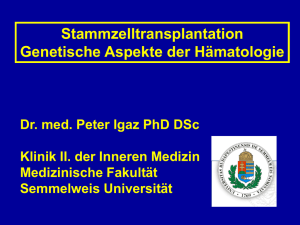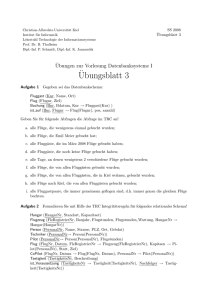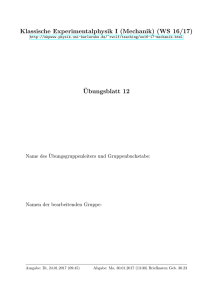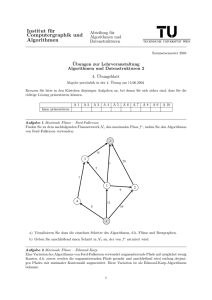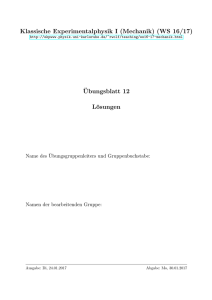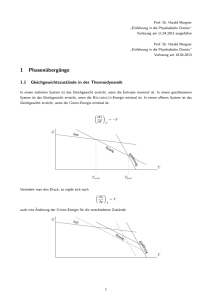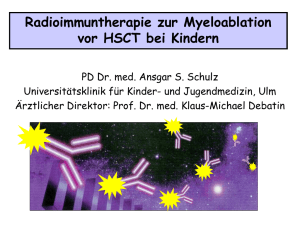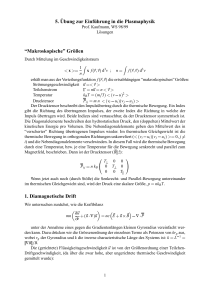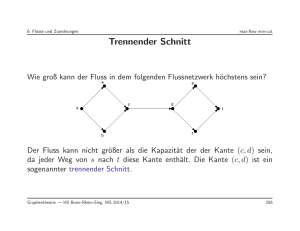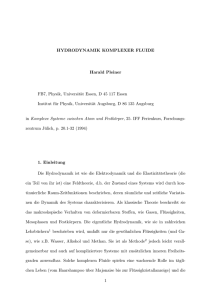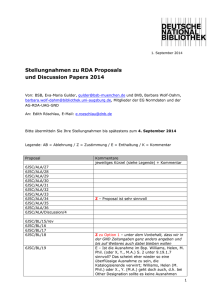that encodes a negativeregulatorof - ETH E
Werbung
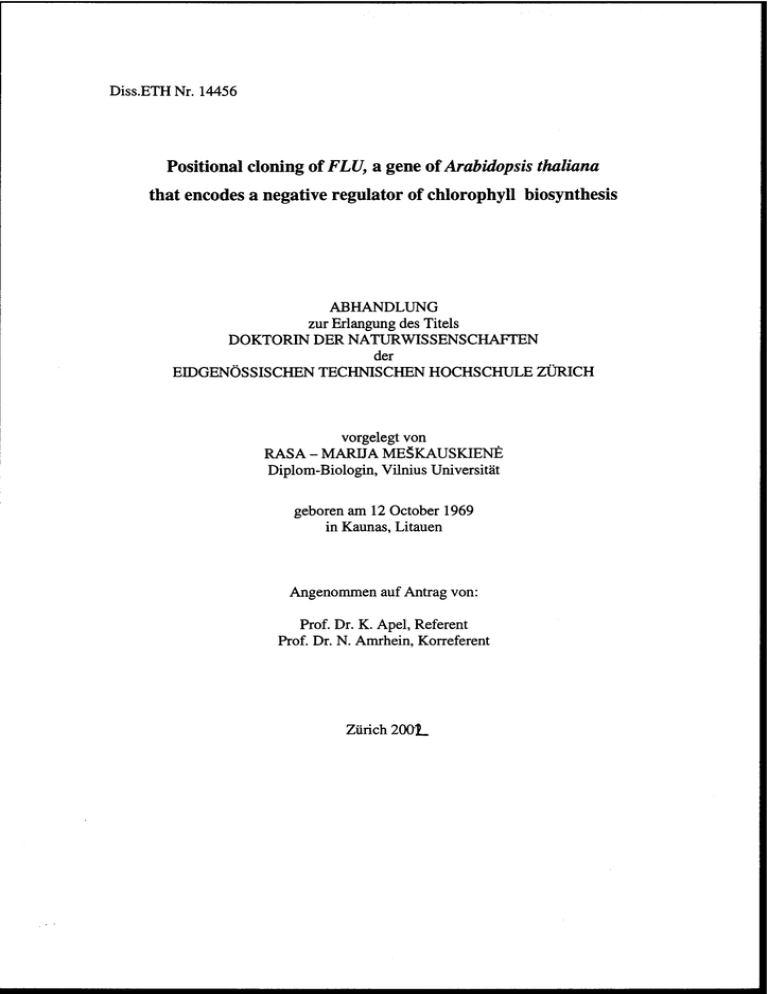
Diss.ETH Nr. 14456 Positional cloning of FLU, a gene of Arabidopsisthaliana that encodes a negativeregulatorof Chlorophyll biosynthesis ABHANDLUNG zur Erlangung des Titels DOKTORINDER NATURWISSENSCHAFTEN der EIDGENÖSSISCHENTECHNISCHENHOCHSCHULEZÜRICH vorgelegtvon RASA MARUA MESKAUSKIENE Diplom-Biologin, VilniusUniversität - geboren am 12 October 1969 in Kaunas, Litauen Angenommenauf Antrag von: Prof. Dr. K. Apel, Referent Prof. Dr. N. Amrhein, Korreferent Zürich 20Ql_ Abstract 7 Abstract Tetrapyrroles such as Chlorophyllsplay a fundamental role in the energy absorptionand transduction activities of photosynthetic organisms. Because of these molecules, however, photosyntheticorganisms are tetrapyrrole biosynthesis and to prevent the accumulation of free intermediates that potentially are extremely destructive when illuminated. In angiosperms, the metabolic flow of tetrapyrrole biosynthesis is regulated at the step of 5-aminolevulinicacid (ALA) synthesis. Several mechanisms have been previously implicated to control ALA synthesis. Light, diurnal rhythms, and functional Status of the plastid regulate the expression of genes that code for the two enzymes, glutamyl-tRNA reductase and glutamate-l-semialdehyde-2-l-aminotransferase, committed to ALA synthesis. Heme-dependent feedback inhibition of ALA synthesis has been proposed and supported by several sets of data. Mg-chelatase, the enzyme at the branch point of Chlorophyll and heme biosynthetic pathways, seems to be also involved in the regulation of ALA synthesis in a way different from the hemedependent inhibition. In angiosperms, the Chlorophyllbiosynthesis pathway leads only to the formation of protochlorophyllidein the dark, since NADPH:protochlorophyllideoxidoreductase, the enzyme that converts protochlorophyllideto chlorophyllide, requires light as a cofactor. Once a critical level of protochlorophyllidehas been reached, ALA synthesis slows down. A genetic approach led to the isolation of an Arabidopsis thaliana mutant that is no longer able to suppress the accumulation of protochlorophyllidein the dark. In this mutant,flu, the rate of ALA synthesis exceeds that of the wild type by a factor of three to four. Thus, the FLU gene encodes a negativeregulator of ALA synthesis. The work presented describes the map-based cloning of the FLU gene. The identification of FLU was confirmed: 1) single point mutations were found in this gene of four allelic flu mutants and 2) the flu phenotype was complemented by introducing the wild type copy of the gene into mutant plants. In the Arabidopsis genome, FLUis a single gene and not a member of a gene family. It encodes a novel, previously not described protein. The FLU protein is very likely located in plastids since it was imported and processed by isolated pea chloroplasts. FLU was tightly associated with chloroplast membranes. The hydrophobic region adjacent to the transit peptide of FLU to evolve highly efficient strategies to also prone to photooxidativedamage. They had control Abstract 8 mightbe responsible for this association. Two domains, coiled-coil and tetratricopeptide repeat (TPR) that are known to mediate protein-protein interactions, were predicted in FLU by Computer programs. The TPR domain, which occupies the C-terminal part and consists of at least two TPR motifs, is very likely a functional unit. In the./7wl-l mutant, the alanine residueat position 20 of the first predicted TPR motif had been replacedby valine. This alanine residue is one of the few highly conserved amino acid residues of TPR motifs. It has been shown to be important for the structural integrity of a TPR. The coiled-coil domain of FLU, which is adjacent to the hydrophobic region, might also be a functional unit. The amino acid Substitution in ./Z« 1-4 was foundin this domain and the probability for the mutated domain to form a coiled-coil structure is lower than that for the native domain. It was shownthat FLU is not involved in the light-dependentregulation of expression of encoding synthesizing enzymes. The predicted features of the FLU protein suggest that FLU confers its regulatoryeffect through interaction with another protein(s),possibly with enzyme(s) of Chlorophyllbiosynthesis. genes the ALA Zusammenfassung Zusammenfassung photosynthetischen Organismen spielen Tetrapyrrole, z.B. Chlorophylle, grundlegende Rollen bei Energieabsorptions- und Transduktionsprozessen. Diese Moleküle können allerdings auch zu photooxidativen Schäden führen. PhotosynthetischeOrganismen mussten daher leistungsfähige Strategien zur Kontrolle der Synthese von Tetrapyrrolen entwickeln, um die Akkumulation freier Zwischenprodukte zu verhindern. Diese Zwischenprodukte können bei Belichtung grosse Schäden anrichten. In Angiospermen wird die Tetrapyrrol-Synthese vor der Vorstufe zu 5-Aminolävulinat (ALA) reguliert. Es wurden verschiedene Möglichkeiten zur Kontrolle der ALA-Synthese in Betracht gezogen: 1) Zwei Enzyme, die GlutamyltRNA reduktase und die Glutamat- l-semialdehyd-2-l-aminotransferase,synthetisieren ALA. Licht, der Tagesrhythmus sowie der Zustand der Piastiden kontrollieren die Expression der Gene, die für diese zwei Enzyme kodieren. 2) Es gibt experimentelle Hinweise für die vom Häm ausgehende "feedback"-Hemmung der ALA-Synthese. 3) Magnesium-Chelatase, das Enzym, das an der Verzweigung der Biosynthese von Chlorophyll und Häm wirkt, scheint ebenfalls in die Kontrolle der ALA-Synthese in einer Weise involviert zu sein, die sich von einer Häm-abhängigen Hemmung In unterscheidet. Bei den Angiospermen führt im Dunkeln der Chlorophyll-Biosyntheseweg nur zu Protochlorophyllid, weil die NADPH:Protochlorophyllid-Oxidoreduktase, das Enzym, das Protochlorophyllidin Chlorophyllid umwandelt, lichtabhängig ist. Sobald eine kritische Menge an Protochlorophyllid entstanden ist, wird die ALA-Synthese verlangsamt. Mittels eines genetischen Ansatzes wurde eine Arabidopsis thaliana Mutante isoliert, die die Akkumulation von Protochlorophyllidim Dunkeln nicht mehr unterdrücken kann. In dieser Mutante, flu, übersteigt die Rate der ALA-Synthese die der Wildtyppflanze um einen Faktor von drei bis vier. Aus diesem Grund kodiert das FLU Gen wahrscheinlichfür einen negativen Regulator der ALA-Synthese. Die vorliegende Arbeit beschreibt die Klonierung und teilweise Charakterisierungdes FLU Gens. Die Identität des FLU Gens wurde bestätigt: 1) In vier unterschiedlichen allelischen Mutanten wurden jeweils verschiedene Punktmutationen in diesem Gen gefunden. 2) Der flu Phänotyp konnte durch eine Wildtyp Kopie des Gens komplementiert werden. Zusammenfassung 10 Im Arabidopsis Genom ist FLU ein einzelnes Gen und nicht Mitglied einer Genfamilie. unbekanntes, bis jetzt nicht beschriebenes Protein. Das FLU Protein ist mit hoher Wahrscheinlichkeitin den Piastiden lokalisiert, da es von isolierten Erbsen Es kodiert für ein Chloroplasten importiert und prozessiert wurde. FLU war fest mit den Membranen der Chloroplasten assoziiert. Die hydrophobe Region unterhalbdes Transitpeptids des FLU Verbindung verantwortlich sein. Zwei Domänen, „coiled-coil" und „tetratricopeptide repeat" (TPR), die für ihre Protein-Bindungs-Eigenschaften bekannt sind, wurden durch Computerprogramme in FLU vorausgesagt. Die TPR Proteins könnte für diese Domäne, die aus mindestens zwei TPR Motiven besteht, ist mit hoher Wahrscheinlichkeit eine funktionelle Einheit. In der Mutante flul-l ist Alanin, das an Postion 20 des ersten vorausgesagten Motivs liegt, durch Valin ersetzt. Dieses Alanin ist wenigen hochkonservierten Aminosäuren der TPR-Motive. Es ist gezeigt worden, dass diese Aminosäure für die strukturelleVollständigkeiteines TPR wichtig ist. Die „coiled-coil" Domäne des FLU Proteins im Anschluss an die hydrophobe Region könnte auch eine funktionelle Einheit sein. InyZwl-4 wurde innerhalb dieser Domäne ein Aminosäureaustausch gefunden. Laut Computerprogrammen ist die eine der Wahrscheinlichkeit, dass die mutierte Domäne eine „coiled-coil" Struktur bildet, niedriger als die der Wildtypdomäne. Es wurde ebenfalls gezeigt, dass FLU nicht an der lichtabhängigenExpressionskontrolle der Gene, die für die ALA synthetisierenden Enzyme kodieren, beteiligt ist. Computer¬ berechnete Eigenschaften des FLU Proteins deuten darauf hin, dass FLU seine regulatorische Funktion sehr wahrscheinlich durch Interaktion mit (einem) anderen Protein(en) ausübt, vielleichtmit Enzyme(n) der Chlorophyll-Biosynthese.
